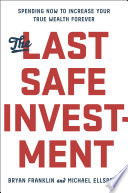

The core premise of 'The Last Safe Investment' is that the most reliable investment you can make is in yourself. This encompasses a wide array of aspects including education, skills, and personal development. The authors argue that traditional investment routes, such as stocks and real estate, can be volatile and unpredictable. In contrast, investing in your own abilities and knowledge provides a return that is often more stable and enduring. By enhancing your skills, you increase your value in the job market and your ability to generate income. This idea encourages readers to prioritize lifelong learning and self-improvement as a means to secure financial stability and personal fulfillment.
Continue readingThe book emphasizes the significance of having the right mindset when it comes to investment and personal growth. A growth mindset, as opposed to a fixed mindset, allows individuals to embrace challenges, learn from failures, and seek out new opportunities. The authors suggest that a positive mindset can lead to better decision-making and a greater willingness to take calculated risks. This concept is crucial in the context of investments, as it influences how individuals perceive their potential for success and their ability to adapt to changing circumstances. By cultivating a growth mindset, readers can position themselves for greater achievements in both their personal and professional lives.
Continue readingIn the modern economy, personal branding has become an essential component of career development. The authors discuss how individuals can create and manage their personal brands to enhance their visibility and attractiveness to potential employers or clients. This includes leveraging social media, networking, and showcasing one’s skills and achievements. A strong personal brand can open doors to new opportunities and facilitate connections that are vital for career advancement. The book provides practical strategies for developing a personal brand that resonates with one’s professional goals and aligns with market demands.
Continue readingThe authors advocate for a diversified skill set as a means to remain competitive in an ever-evolving job market. They argue that relying on a single skill or area of expertise can be risky, especially as industries change and new technologies emerge. By acquiring a range of skills, individuals can adapt to various roles and industries, thereby increasing their employability and income potential. The book outlines methods for identifying complementary skills and provides guidance on how to pursue continuous education and training in multiple areas.
Continue readingNetworking is presented as a critical investment in one’s career and personal development. The authors explain that building and nurturing professional relationships can lead to valuable opportunities, insights, and collaborations. They emphasize the importance of genuine connections over superficial networking, advocating for a mindset of giving and supporting others in the community. The book offers actionable tips for effective networking, including how to approach conversations, follow up with contacts, and maintain long-term relationships that can benefit both parties.
Continue readingWhile the book emphasizes investing in oneself, it also addresses the importance of understanding financial literacy and investment strategies. The authors argue that knowledge about personal finance, investing principles, and market dynamics is crucial for making informed decisions. They encourage readers to educate themselves on various investment vehicles, risk management, and financial planning. This knowledge empowers individuals to make better choices regarding their financial futures, ensuring that they can navigate the complexities of the investment landscape with confidence.
Continue readingThe final key idea revolves around the notion of failure as an essential part of the growth process. The authors contend that setbacks and failures should not be viewed negatively; instead, they should be seen as opportunities for learning and improvement. By reframing failure in this way, individuals can develop resilience and a more robust approach to challenges. The book encourages readers to reflect on their experiences, extract lessons from their failures, and apply these insights to future endeavors, thereby fostering a culture of continuous improvement.
Continue reading